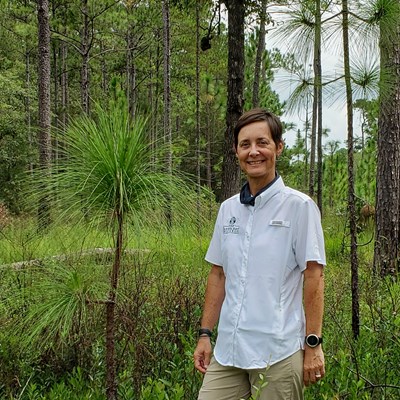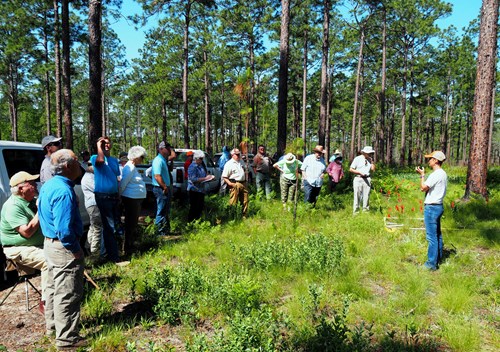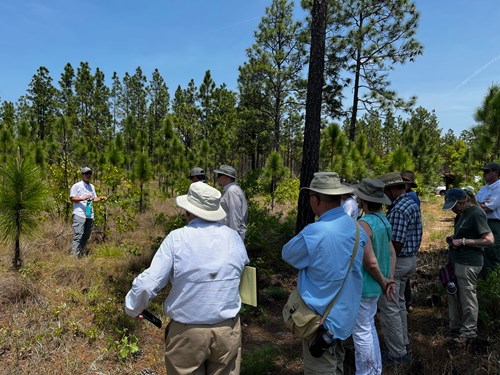Interview With The 2023 Longleaf Partnership Council Chair

Get to know the 2023 Chair of the Longleaf Partnership Council, Carol Denhof! Carol is the President of The Longleaf Alliance, leading the organization in its mission to ensure a sustainable future for the longleaf pine ecosystem through partnerships, landowner assistance, and science-based education and outreach.
Recently, Carol was interviewed for her thoughts on a variety of topics regarding longleaf pine and America’s Longleaf.
1. Your longleaf roots go back deep. What led you to devote much of your professional life to longleaf pine?
My background is in plant ecology and going all the way back to my graduate school days, the plants that I’ve been most passionate about grow in and around longleaf pine habitats. For my master’s degree project, I was able to study the plant species that inhabited a tract of land in southeast Georgia that contained both longleaf-turkey oak sandhills and pitcher plant bogs. This project ignited my love for this iconic longleaf ecosystem and led me to concentrate my focus on the diverse groundcover components of the forest. Of course, the tree itself is special with its unique life stages, relationship with fire, and the premium forest products it provides, but the draw of longleaf, and the reason we do what we do, lies within the ecosystem where it resides. It’s inspiring to work in a system that plays such an important role in providing essential ecosystem benefits here in the Southeast.
2. ALRI is all about partnership. What are the key elements to successful partnership?
It is true, the successes of America’s Longleaf can be directly traced to the working partnerships that exist within the Longleaf Partnership Council and the Local Implementation Teams that work collaboratively across the nine-state range of longleaf to facilitate real change on a landscape scale. This is no easy task but having representation from all sectors within the longleaf community makes these partnerships stronger and brings diverse perspectives to the table in making decisions that guide our work in longleaf restoration and management. Being able to leverage the skillsets and connections of the federal and state agencies, non-profit organizations, industry, and private landowner allows for building strong teams that achieve far more as a team than what we could do individually. Just like the ecosystem is comprised of many parts, the partnership is made up of partners that all play different roles, but we must all come together as a group to achieve the ambitious goals that we have set for range-wide longleaf restoration.
3. Much of the land in the South is privately held by individual landowners. What role can the Partnership play in reaching more private landowners?
With private landowners holding the majority of existing longleaf acreage and most of the land within the range that would be available and appropriate for longleaf restoration also in private ownership, it is especially important to be working with those landowners to ensure that we are not only adding longleaf acres but also maintaining those forests that are currently in longleaf. Within the LIT landscapes, there are numerous opportunities for the Partnership to engage with private landowners through outreach events, restoration programs, and Prescribed Burn Associations. Organizations like The Longleaf Alliance and others that are represented on the LPC have experience and expertise working directly with landowners to provide technical assistance, education and outreach, and cost-share assistance to guide them through the process of longleaf restoration. By advocating for private lands, communicating science-based longleaf-related information to landowners, connecting them with appropriate longleaf restoration programs, and addressing bottlenecks that restrict the restoration process, the Partnership will be making every effort to expand longleaf on private lands.
4. We’ll soon be celebrating the 15th anniversary of ALRI. Going forward what do you see as the key elements to success in the coming 15 years?
This is an exciting time for the Partnership as we approach our 15th anniversary and look towards the next phase of America’s Longleaf. Learning from the lessons of the first 15 years, members of the LPC are working collaboratively to update the Range-wide Conservation Plan for Longleaf Pine. This document serves as a working plan that guides the work of the Partnership by setting goals, objectives, and recommended actions for the next 15-year period. While we are still focused on many of the actions included in the original plan that was produced in 2009, some priorities have shifted over the years due to new and changing needs. We have the opportunity with this update to be more strategic with our goals, utilize innovative tools for measuring success, and incorporate new approaches to expanding longleaf restoration across the landscape in the context of climate resilience, all while bringing a wider variety of partners into the effort. I see these as our keys to success moving forward – by involving more and different voices and viewing longleaf restoration through the lens of how this ecosystem brings advantages not found with other forest types will lead to the Partnership’s collective work widening the impact that longleaf forests have in our region.
5. We talk about longleaf as if it is one tree, but of course, we are talking about the whole ecosystem. What’s your favorite plant or animal that calls longleaf home?
As a plant person, this is a tough question to answer. The longleaf forest is home to hundreds of plant species and asking me to pick my favorite is like asking me to pick my favorite child. Each has their special characteristics, function, and season that make them stand out. For example, wiregrass is important for its function in fire, pitcher plants for their charisma and carnivorous ways, and plants like sandhills milkweed for their beauty and ability to survive in some of the toughest longleaf habitats. In all my years working in longleaf systems though, the plant species that rises to the top is American chaffseed (Schwalbea americana). An understated and easily overlooked plant unless it is in flower, it is a federally endangered hemiparasitic species with limited occurrences across the range. The majority of the populations occur in South Carolina, but I was fortunate to be able to work extensively with the species during my time working at the Jones Center at Ichauway and then at the Atlanta Botanical Garden. Its dependence on other longleaf understory species, host specificity, and response to fire make it such an interesting plant to study. To find this rare plant blooming in the spring makes for an extremely exciting day in the field!

Photo by Randy Tate

Photo by Lisa Lord

American chaffseed (Schwalbea americana); Photo by Carol Denhof
Archive
- February 1
- March 1
- June 2
- November 1
- February 1
- March 1
- May 1
- June 1
- July 2
- August 1
- October 1
- November 1
- December 1
- January 3
- February 2
- March 1
- June 1
- August 2
- May 1
- October 1
- November 1
- January 2
- February 1
- April 2
- June 3
- July 3
- August 3
- March 2
- October 1
- November 1
- August 4
- September 3
- November 2
- December 2
- June 2
- May 1
- April 2
- March 2
- February 1
- January 2
- January 1
- March 1
- May 2
- June 2
- August 1
- September 1
- November 1
- December 2
- January 1
- March 1
- May 2
- June 3
- July 1
- August 1
- September 1
- October 1
- November 2
- January 2
- February 1
- April 2
- June 1
- July 2
- August 2
- November 3
- December 3
- February 3
- April 2
- May 2
- June 1
- July 2
- August 2
- September 1
- October 2
- November 2
- December 1
- January 2
- February 2
- April 1
- May 1
- June 1
- July 4
- August 1
- September 1
- October 2
- November 2
- February 1
- May 2
- March 1
- June 3
- January 1
- July 1
- August 1
- October 1
- November 1
- April 3
- May 1
- June 3
- August 1
- September 2
- October 1
- December 2
- December 1

